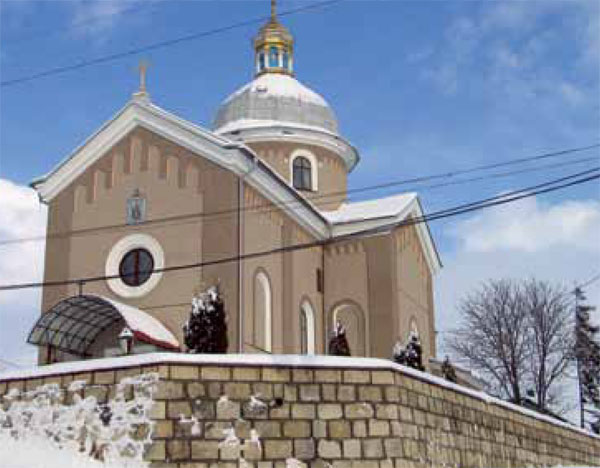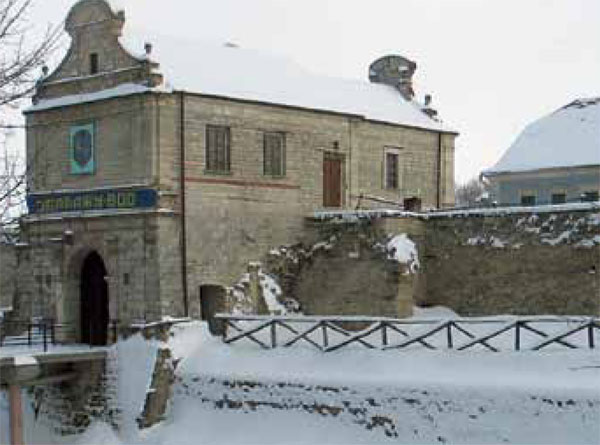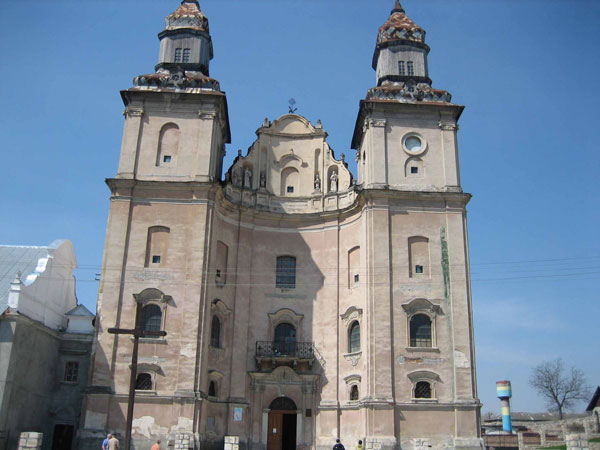The tranquil Ternopil–Lanivtsi train stops and I jump out into a giant snow drift whose pristine white surface has completely concealed the rails and platforms of the Zbarazh train station. A memorial plaque announces that Symon Petliura once honoured this place with a personal visit. Zbarazh is starkly different from the standard historical towns of Galicia. Here, historical monuments, the spirit of the past, and old block apartments are not crammed together but are, rather, mixed in with the realities of other epochs. Everything in Zbarazh is interlaced, creating eclectic montages. Here is a woman sitting in a sleigh pulled by two horses and a foal against the background of trashy glamorous ads, shabby Soviet-era five story buildings and a somewhat pretentious post-Soviet drugstore. Nearby stands a factory – picturesquely ruined as if by a mini-bombardment and put up for sale – and, almost directly across the street from it, an old Jewish cemetery. A no less Zeitgeist-imbued Catholic cemetery with statues, crosses and burial vaults is a stone’s throw away.
THE HUMAN FACTOR
In winter, the streets of Zbarazh are almost empty apart from a few central ones. Yet you might befriend a cute dog or adventurous cat that will be happy to guide you to the local castle. Here you also have a chance to meet Nadiyka Herbish, a young but already quite well known Ukrainian writer, who tells you a little about the modern human aspect of her home town. “There is a certain cultural life here: concerts (usually by the castle), exhibitions and historical re-enactments. Some festivals attract representatives of the Goth subculture from all over Ukraine and abroad. There are also painters and sculptors here. In particular, wood carving has been a recent hit with tourists who come here in large numbers, especially from Poland. Naturally, the town does not have higher education institutions – only general and vocational schools. Jobs are pretty scarce. Unfortunately, many locals become migrant workers in Western Europe.” They are said to have significantly driven up local real estate prices with their investments.
THE OLD CENTRE
The Zbarazh synagogue, built in 1537, has undergone a sad metamorphosis. After a number of transformations and remodelling efforts it has emerged as one of the buildings of the local vodka distillery owned by a fairly well known brand.
The oldest church in town, the Orthodox Assumption Cathedral, has also had its share of trouble. The earliest written records of the church date back to the late 16th century. According to historians, in the 18th century it was turned into the Saint Joseph and Victoria Cathedral, which burned down soon thereafter. The building rose again as a monastery of the Trinitarian Order but was closed by the Austrian authorities by the end of the century. The building was later handed over to the Ukrainian community to be used as a church. This story is further proof that interdenominational Christian wars over church buildings are an old tradition in the Ukrainian lands rather than an apocalyptic sign of the “mad 1990s”. In any case, the building is now used by the Ukrainian Orthodox Church (Kyiv Patriarchate) and looks elegant and tidy.

The Greek Catholic Church of the Lord’s Ressurection was also built in the 18th century thanks to donations from Mikolaj Potocki and Zbarazh native Hryhohiy Hymoniuk. It has been rebuilt multiple times over the course of time and now appears massive and not the least bit Baroque.
READ ALSO: Solomia’s Solo
Located between these two churches are quaint old city blocks. Many buildings are, however, in very poor repair. Some others have been remodelled in a weird fashion. Typical Soviet buildings are interspersed among old ones, totally in line with Zbarazh’s eclectic style.
However, the entire central part of town is dominated by the former Berdardine Monastery, specifically its grand Baroque-style Saint Anthony Cathedral. It too was constructed in the 18th century to a design by architect Johann Ganz. Devoid of plentiful decorations on the outside, the church nevertheless appears elegant and rich. After the fall of the Soviet regime it was handed back over to the local Roman Catholic community whose population was decimated by earlier deportations and “population exchanges”. A chapel erected by the descendants of the Lemkos who were forcefully resettled here points to the Ukrainian dimension of this “exchange” and serves as a reminder of Operation Vistula. An original bell tower designed by the same architect stands out from the rest of the former monastery buildings. A church school and a gymnasium-type school operated in the monastery beginning in the 18th century, and it now houses a music school.

THE FINAL SPRINT
After crossing the narrow and rushing Hnizna River that weaves its way through town, I find myself on a hill leading to the castle. It is not very high but fairly steep. Sprawled over the hillside is an old park with an obelisk dedicated to Adam Mickiewicz, a World War II monument, and other sculptures. When I finally reach the top of the hill, the castle initially comes across as somehow insufficiently monumental and spectacular. But it withstood a Cossack siege, and there are plenty of nooks and crannies to be examined here. In the 2000s, the building was extensively renovated. It is now in good condition and figures prominently on postcards depicting Ternopil Oblast’s many castles. However, the restoration effort has been less than perfect, especially in regards to the interior. This Renaissance palazzo in fortezza was designed by Italian architect Vincenzo Scamozzi in the 17th century, but the original design was later modified by Dutch military architect Henrik van Peene.
READ ALSO: Noble Walls
The castle now hosts various exhibitions of icons, furniture, embroideries and even musical instruments. A curious visitor will find plenty of replicas of old portraits, including those of the castle’s numerous owners and their relatives – the Zbaraskis, the Wisniowieckis, the Poniatowskis, etc. The castle is not the only thing to see here: a relatively new and well-proportioned church with a slight Balkan flavour is perched atop a nearby hill. A large lake lies in the foothills below. In the Polish novel With Fire and Sword and the film of the same name, it witnesses the defence of Zbarazh besieged by the huge army of Bohdan Khmelnytsky. But in the snowy winter of 2013, nothing but the occasional fisherman disturbs its peace and quiet.

SOME NOTABLE NATIVES AND RESIDENTS OF ZBARAZH
Dmytro Kliachkivsky, aka Klym Savur, the first UPA commander in Volhynia
Ida Fink, a Polish writer of Jewish background who wrote primarily about the Holocaust
Kazimierz Zipser, a Polish railway engineer who was the rector of Lviv Polytechnic Institute in the interbellum years
Jozef Wereszczynski, a 16th-century polemical writer who was also a Catholic bishop in Kyiv
Karol Kuryluk, a Polish journalist and publisher who published, among other things, the noted Lviv magazine Sygnaly
Zbarazh
Zbarazh is a raion or county centre in Ternopil Oblast with a population of 14,000. The first written record of Zbarazh dates back to 1211. The first wooden castle was built here in the late 14th century by Dmytro Korybut. In 1463, the city was handed over to Vasyl Nesvitsky, who adopted the surname Zbarazky. In 1474, the Tatars burned the castle together with its defenders and ruined the rebuilt castle again in 1598. The citadel was moved to the location of the current castle beginning in 1626–31. The Zbaraskis later yielded the town to the Wisniowieckis. The Cossacks besieged the castle during the Bohdan Khmelnytsky rebellion, and Jeremi Wisniowiecki, a notable historical figure, led the defence. The castle received reinforcements and held out, partly thanks to the fact that the Crimean khan demanded a truce from Khmelnytsky. The Siege of Zbarazh and the Battle of Zboriv resulted in the Treaty of Zboriv, which was not beneficial to Ukraine and lasted for only a short time.

